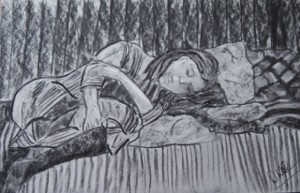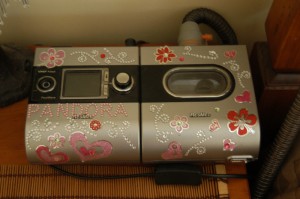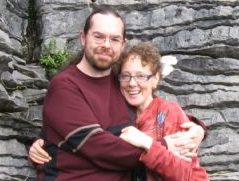ONDINE’S CURSE – a children’s social story about Central Hypoventilation/CCHS

ONDINE’S CURSE by Donna Williams
Linda and Polly were in the same class.
Linda liked dolls, Polly liked colored glass.
Linda liked eating macaroni and cheese.
Polly like mud pies and climbing up trees.
Linda was having a birthday quite soon
there would be sausage rolls, cakes and silly balloons.
There would be games and music, friends would sleep at her place.
Then she asked Polly’s mother, oh, the look on her face…
Polly’s mother was worried… for when children would sleep
they would just close their eyes and begin counting sheep.
They would fall fast asleep as their brain kept them breathing.
They’d be safe in their sleep as they slept through the evening.
They did not sleep like Polly, who had a sleeping machine.
Her machine kept her breathing as she went into dreams.
Her machine did the job because her brain had forgot
how to keep Polly breathing in her sleep since her cot.
‘Can Polly come to my party?’, Linda begged Polly’s mum,
‘All my friends will be coming, please, oh, can Polly come?
It’s a party where where kids bring pyjamas and sleep’…
But Polly’s mother looked sad and began now to weep.
‘Can I go to the party, Mum?’, asked Polly now.
Her mother looked into Polly’s eyes with a frown,
shook her head and said, ‘Polly, you know you need your machine’…
‘Well I’ll take it there with me!’, said Polly, and beamed.
Linda’s mum spoke to Polly’s mum about the machine
and the rules how to use it, keep it safe, keep it clean,
the alarms and the buttons, and the tubes and the mask.
Polly’s mum thought it would be an impossible task.
The machine was a ‘vent’, Linda’s mum was a nurse,
but she had never heard of the name ‘Ondine’s Curse’.
As she listened she learned Polly’s brain had forgot
how to keep Polly breathing since she was just a tot.
Linda’s mum came to Polly’s house, to learn about the ‘vent’
She learned about how Polly’s mother had spent
all these years full of worry that Polly might try
to sleep without her machine, and, not breathing, could die.
And the mums had a cry for it was sad that their girls
were in the same class but in two different worlds.
Though they looked not so different to each other by day,
when asleep they each slept in such different ways.
Well Linda’s party came around and her friends had arrived.
Reka couldn’t eat gluten but had so far survived.
Peta had lost her phone and now had a cry.
Polly arrived and the children asked why
Polly had this machine to set up by a bed.
‘What a strange thing to bring to a party’, they said.
Linda’s mum had assured Polly’s mum it would be
all ok, with the vent all set up quite safely,
and the children had learned their most important task
to make sure Polly not sleep without wearing her mask.
The games and the food left all ready for bed.
The kids all laid down to rest now sleepy heads.
But with mask and machine Polly felt quite alone.
She watched all the children sleeping safe without one.
Just once, Polly wanted to know what it’s like,
to be like other kids, for just one single night.
By the light of the moonlight, she watched Linda’s face,
peaceful in sleep, wanting just to swap place.
Then Polly, being silly, turned off her machine.
It would just be a minute, just pretend to go sleep.
She wouldn’t dare sleep without wearing her vent.
She understood it could kill her and had learned what that meant.
It would not really happen… she told herself as a dream,
tricked her she was awake, but instead fell asleep.
Linda’s mother came in to check all was ok
It had only been minutes, Polly slumbered away.
Without mask, her vent off, Polly now had turned blue.
Linda’s mother, the nurse, knew what she had to do.
Polly’s brain had no air as she slept in a dream.
Linda’s mother quickly started up Polly’s machine.
Polly’s heart was in trouble, trying to keep her alive.
Linda’s mother worked quickly to help Polly survive.
If Polly had died, she would never awake.
She would never again see a party or cake.
She would never again see her family or friends.
She would never have life for it would all be The End.
But Linda’s mother had saved Polly’s life on that night.
Polly had been so lucky, it had been such a fright.
Polly’s brain had been hurt from when she didn’t have air
And learning got harder and she couldn’t stay in a chair.
She had trouble to understand what people said.
It would take time to fix how she’d broken her head.
Polly stayed friends with Linda, but found a new friend
who lived far far away in a place called Land’s End.
And this friend had to sleep with a machine like her own.
They talked on computer, each in their own home
in countries that were on different sides of the world…
Polly finally felt she was like other girls.
About The Author:
 I am an adult with an Acquired Central Hypoventilation Syndrome due to asphyxiation related brain injury aged 2-3 years old in a wider context of having a collagen disorder, EDS III/IV which effects fatigability of muscles, including respiratory muscles.
I am an adult with an Acquired Central Hypoventilation Syndrome due to asphyxiation related brain injury aged 2-3 years old in a wider context of having a collagen disorder, EDS III/IV which effects fatigability of muscles, including respiratory muscles.
I had my first episode of noted cyanosis at age 2-3 and was diagnosed with autism aged 2-3 years old. I drowned twice at age 3 after sinking to the bottom of pools and making no effort to swim and in late childhood found I could swim the 100 metre olympic pool on the bottom without coming up for breath. I survived the euphoria and ongoing mild brain injury of hypoxic episodes and managed to acquire functional speech by late childhood. Among my first complex questions was ‘why do other people’s brains keep them breathing and mine keeps forgetting’.

I was put on ventilation in adulthood following exacerbation of the original brain injury. I’m on a Resmed VPAP S9 Adapt (a bilevel machine) which I named ‘Pandora’ after the film Avatar in which the Sam Worthington character uses ventilation and recently gave my machine a bling makeover to make it less ‘medical looking’. I take over from the machine around once every 30-90 min. I sometimes also require daytime ventilation for daytime hypoventilation episodes and have a portable machine for this so I can continue with activities. I recently accidentally fell asleep without my ventilation and was woken by my heart vibrating in atrial fibrillation so have no doubt where I’d be if the strangeness of that hadn’t woken me.
Having read about children with Congenital Central Hypoventilation I wanted to write a social story for those children who were rebelling against ventilation or struggling with associated self esteem or self image in never having met others who sleep as they do. I hope to be turning this story into an illustrated E-book for children with hypoventilation and those explaining the condition to children or others without the condition.
 Today I live happily with my wonderful husband Chris and our two cats. After 20 years as an autism consultant I am presently an art teacher.
Today I live happily with my wonderful husband Chris and our two cats. After 20 years as an autism consultant I am presently an art teacher.
LOOKING FOR FEEDBACK: most kids with ACQUIRED Central Hypoventilation– ACHS – (their brain stops giving them the messages to keep breathing during sleep… some with it also have daytime episodes) will be diagnosed with Mixed Apnea, or Idiopathic Central Apnea.
This is NOT Obstructive Apnea (ie snoring, collapsed airway) which is a MECHANICAL fault, not a NEUROLOGICAL one. Untreated apnea can cause ongoing untreated hypoxia (oxygen starvation) which may cause developmental disabilities in around 42% of those left untreated.
Most of these children may be diagnosed as autism these days, so they may also be non verbal children whose ACHS has not been diagnosed yet and who can’t tell you their ‘brain keeps forgetting to keep them breathing’.
If a child has ongoing untreated Obstructive Apneas they may have minor undiagnosed strokes (50% of infant strokes are not found on MRI). These can CAUSE an Acquired Central Hypoventilation Syndrome, as can any significant oxygen starvation episode, which is how I got ACHS when I was 2-3 years old (it was only diagnosed and treated in 2012). I personally have heard of quite a number of kids with autism who have cyanotic (turning blueish) episodes and seizures, which can be related to ongoing hypoxia, effect 70% of those with autism.
Several genetic and some neurodegenerative conditions that overlap with autism sometimes also come along with higher incidence of not just obstructive but also central apneas. Among these are also Fragile X and also Downs. Ehlers Danlos Syndrome also comes with autonomic dysfunction, muscle fatigability (including respiratory muscles) and Obstructive Apnea which untreated could contribute to hypoxic (lack of oxygen) events that ultimately culminate in Central hypoventilation (where the brain starts to lose its messages to keep the person breathing).
Please, if this sounds like it MAY be you or your child, let me know and please join my FB page for ACHS where we can discuss it.
Donna Williams, BA Hons, Dip Ed.
Author, artist,and presenter.
http://www.donnawilliams.net
I acknowledge Aboriginal and Torres Strait Islander people as the Traditional Owners of this country throughout Australia, and their connection to land and community.
